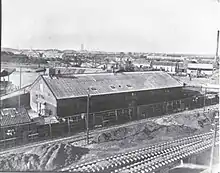Arakawa, Tokyo
Arakawa (荒川区, Arakawa-ku) is a special ward located in Tokyo Metropolis, Japan. The ward takes its name from the river, the Arakawa, though the Arakawa River does not run through or touch the ward. Its neighbors are the wards of Adachi, Kita, Bunkyo, Taito and Sumida. In English, the ward calls itself Arakawa City.
Arakawa
荒川区 | |||||||||||
|---|---|---|---|---|---|---|---|---|---|---|---|
| Arakawa City | |||||||||||
 Sumida River from Suijin Bridge in Arakawa | |||||||||||
 Flag  Emblem | |||||||||||
 Location of Arakawa in Tokyo Metropolis | |||||||||||
 Arakawa Location in Japan | |||||||||||
| Coordinates: 35°44′N 139°47′E | |||||||||||
| Country | Japan | ||||||||||
| Region | Kantō | ||||||||||
| Prefecture | Tokyo Metropolis | ||||||||||
| Government | |||||||||||
| • Mayor | Taichiro Nishikawa (since November 2004) | ||||||||||
| Area | |||||||||||
| • Total | 10.16 km2 (3.92 sq mi) | ||||||||||
| Population (May 1, 2015) | |||||||||||
| • Total | 208,763 | ||||||||||
| • Density | 20,550/km2 (53,200/sq mi) | ||||||||||
| Time zone | UTC+09:00 (JST) | ||||||||||
| City hall address | Arakawa 2-2-3, Arakawa, Tokyo 116-8501 | ||||||||||
| Website | www | ||||||||||
| |||||||||||
Arakawa has sister-city relationships with Donaustadt in Vienna, Austria, and with Corvallis, Oregon, U.S. Domestically, it has similar relationships with nine cities, towns and villages.
As of May 1, 2015, the ward has an estimated population of 208,763, and a population density of about 20,550 persons per km². The total area is 10.16 km².
Geography
Arakawa is in the northeastern part of Tokyo. The shape is long and narrow, stretching from west to east. The Sumida River forms the northern boundary.
The ward is surrounded by five other special wards. To the north lies Adachi; to the west, Kita; to the southwest, Bunkyo. South of Arakawa is Taito, and southeast is Sumida.
History
The area was mainly agricultural in the Edo period. In 1651, Kozukappara, the Tokugawa's largest execution ground (now located next to Minami-Senju station), was built. Beginning in the Meiji era, the area became industrial as factories were built on the water front.
In 1932, it became one of the 35 wards of Tokyo City.

On 1 July 1944, during World War II, the Imperial Japanese Army established a Prisoner of War camp named #20-B, on the grounds nearby Hashiba Bridge, Minami-Senju, Arakawa, at the current day location with the address of 3-41 Minami-Senju, Arakawa. The camp was renamed to #10-B, in August 1945.[1][2] The prisoners of the camp were liberated in September 1945.[3] At the time, there were 256 prisoners of war (87 British, 64 American, 55 Canadian and 50 Dutch) held at the camp. Two prisoners of war died during their imprisonment.[4]
Districts and neighborhoods
|
|
Notes:
a - (1-chōme)
b - (1, 2, 3, 4 & 8-chōme)
c - (2, 3, 4, 5, 6, 7, 8-chōme)
d - (5, 6, 7-chōme)
Notable people
- Kosuke Kitajima (Olympic gold-medalist in swimming)
- Kanako Watanabe (Olympic athlete in swimming)
- Hibari Misora (singer)
- Momoe Yamaguchi (singer, actress)
- Eri Kamei (singer)
- Toru Yano (Professional wrestler)
Economy
MIAT Mongolian Airlines's Tokyo Branch Office is on the fifth floor in the Tachibana Building in Arakawa.[5] Iseki, a tractor and engine equipment manufacturer has its Tokyo head office in the ward.[6]
Landmarks
Education
Public elementary and middle schools are operated by the Arakawa City Board of Education.
Public high schools are operated by the Tokyo Metropolitan Government Board of Education.
- Arakawa Technical High School[7]
- Takenodai High School[8]
- Kaisei Academy
The Tokyo First Korean Elementary and Junior High School (東京朝鮮第一初中級学校), a North Korean school, is in the ward.[9]
The metropolis operated the Tokyo Metropolitan College of Aeronautical Engineering[10][11] in Arakawa until 2010.
Transportation
Rail
- JR East
- Yamanote Line, Keihin Tohoku Line: Nishi Nippori, Nippori Stations
- Joban Line: Nippori, Mikawashima, Minami-Senju Stations
- Tokyo Metropolitan Bureau of Transportation
- Tokyo Sakura Tram (13 stations, including Minowabashi Station)
- Nippori-Toneri Liner: Nippori, Nishi-Nippori, Akado-Shōgakkō-mae, Kumano-mae
- Tokyo Metro
- Chiyoda Line: Nishi Nippori, Machiya Stations
- Hibiya Line: Minami Senju Station
- Keisei Electric Railway Keisei Main Line: Nippori, Shin-Mikawashima, Machiya Stations
- Metropolitan Intercity Railway Company Tsukuba Express: Minami-Senju Station
Additional facilities are under construction.
Major Roads
- Route 4 (the Nikkō Kaidō)
- Meiji Street
- Ogubashi Street
- Otakebashi Street
Events
- Sada Abe incident (1936)
- Mikawashima train crash (1962)
- The attempted assassination of the head of the National Police Agency following an investigation of Aum Shinrikyo-related facilities (1995)
See also
References
- "Tokyo POW Camp #10-B Arakawa". 2019-03-27. Archived from the original on 2019-03-27. Retrieved 2019-10-21.
- "3-chōme-41 Minamisenju". 3-chōme-41 Minamisenju. Retrieved 2019-10-21.
- "Tokyo POW Camp #10-B Arakawa". 2019-03-27. Archived from the original on 2019-03-27. Retrieved 2019-10-21.
- "POW Research Network Japan | Researches | POW Camps in Japan Proper". www.powresearch.jp. Retrieved 2019-10-21.
- "Contact Us." MIAT Mongolian Airlines. Retrieved on July 29, 2016. "TOKYO BRANCH OFFICE 5F, Tachibana Bldg, 2-19-4 Nishinippori, Arakawa-ku, Tokyo 116-0013, Japan "
- "Company Outline." Iseki. Retrieved on March 31, 2018.
- http://www.arakawakogyo-h.metro.tokyo.jp/
- http://www.takenodai-h.metro.tokyo.jp/
- "アクセス." Tokyo First Korean Elementary and Junior High School. Retrieved on October 13, 2015. "116-0014 東京都荒川区東日暮里3-8-5"
- "Tokyo Metropolitan College of Aeronautical Engineering". Tokyo Metropolitan College of Aeronautical Engineering. Archived from the original on 2009-03-09. Retrieved 2016-07-29.
- 東京都立航空工業高等専門学校 (in Japanese). 東京都立航空工業高等専門学校. Retrieved 2016-07-29.
External links
| Wikimedia Commons has media related to Arakawa, Tokyo. |
- Arakawa City Official Website (in Japanese)

